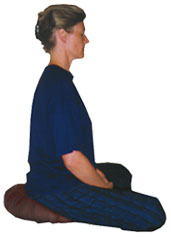Insight Meditation Online
Insight Meditation Workshop
by Ven. Pannyavaro
Instructions for Sitting Meditation
» Sitting postures – demonstrated
The first step in finding a balanced sitting posture is to rest the awareness on the various sitting touch points, softening onto the support given by the cushion/chair.
A balanced, alert posture is then brought about by scanning the body in order to “relax upwards” (you may have noticed how a 5 year old sits up in a balanced way without effort). Allow the head to balance freely on the spine, checking that the head is not pulled back or fixed. Allow the chin to drop so that the eyes and ears are at about the same level.
If sitting on the floor, use cushion(s) so that the knees are below the hips and in contact with the floor (otherwise the back will be collapsed) or else use a chair with a firm base (not a sofa).
Try radiating loving-kindness above and below and in all directions around you to check that you are not holding or contracting in the front or the back , etc. Check that the breathing is free and easy – any restriction indicates a fixed posture.
It is useful to spend 5 minutes scanning the body in this way. Note that there is no such thing as “perfect posture” and postural aches will come and go as a natural part of the unfolding practice. If pain becomes overwhelming or is a signal of injury, mindfully adjust the posture after noting the various sensations. However, as concentration develops, sensations of hotness, stiffness and itchiness will arise as part of the contemplation of feeling/sensation and it is important to note them mindfully without fidgeting.
The ideal is an upright, alert posture. Slumping only increases the pressure on the legs and discomfort in the back. It is important to attend to your posture with wisdom, not insensitive will-power. Posture will improve with time, but you need to work with the body, not use force against it. Use a small firm cushion underneath and toward the back of the buttocks to support the angle of the hips.
If you have a lot of pain during a period of sitting, change posture, sit on a small stool or chair, or stand up for a while.
Checking your posture
- Are the hips leaning back? This will cause a slump.
- The small of the back should have its natural, unforced curve so that the abdomen is forward and ‘open’.
- Imagine that someone is gently pushing between the shoulder blades, while keeping the muscles relaxed.
- Note, and gently release, any tension in the neck/shoulder region.
Instructions for Sitting Meditation:
Settle into a comfortable, upright balanced posture. Then on the basis of working from the gross to the subtle, from the body to the mind, feel the touch sensations of hardness or softness from the body’s contact (earth element). This anchors the attention to the body, especially when assisted by the mental label of ‘touching’,’touching’.
Then tune into the natural rise and fall movement of the lower abdomen, making a mental note or label of ‘rising’, ‘rising’ concurrent with the upward movement, and ‘falling’, ‘falling’ with the downward movement. This gives you a reference point or primary object to establish the attention on.
Having established on the movement of the abdomen as a base be wary of clinging to it. When secondary object arises, such as thinking, sensations or mind-states, they too must be noted until they disappear. Only then, if nothing else takes your attention, return to noting the rising and falling movement of the abdomen as your primary object; but always be prepared to attend to secondary objects (sensations, feelings, mind-states and thinking) as they arise.
NB It is important to be alert to the specific characteristics of the various elements under observation. For example, the series of sensations from the abdomen movement (wind element) or the specific characteristics found in pain such as heat, throbbing, etc. (fire element). Try the traditional sitting posture as it is helpful in intense practice; it gives the right environmental conditions and allows for a fine focus on the body’s elements and subtle mind events.


